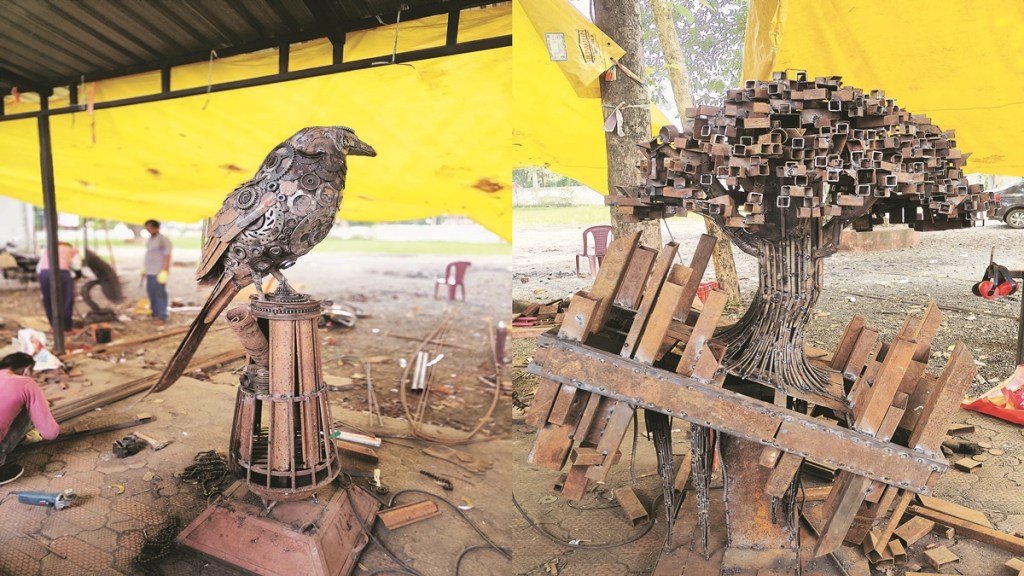Narendra Dewangan is pained by the rampant mining that is wreaking havoc in his home state of Chhattisgarh. A Master of Fine Arts in sculpture, he channels his creative energy to vent his discontent at the destruction of earth that is leading to catastrophic consequences. His new sculpture, titled Environment Balancer, directly addresses the ecological distress.
“We, human beings, are destroying nature through indiscriminate development,” says Dewangan, a former student of Indira Kala Sangeet University in Khairagarh, Rajnandgaon district of Chhattisgarh. Environment Balancer shows a city built inside and outside the earth linked only by a huge tree. “We are not even sparing the ground beneath us,” laments the artist.
Young sculptors
Dewangan is part of four young sculptors from Madhya Pradesh and Chhattisgarh who gathered abandoned automobile parts like motorcycle wheels, chains and bearings to create works inspired by Madhya Pradesh-born modernist painter Sayed Haider Raza to mark his ninth death anniversary on July 23. The sculptures by the four artists using discarded material collected from Mandla, where Raza is buried next to his father’s grave, reflect his artistic philosophy of the infinite, seen in his trademark bindu paintings, underlining the importance of preserving the planet.
At Mandla, a small town on the banks of Narmada in Madhya Pradesh near the famous Kanha Tiger Reserve, where Dewangan and others raced to finish their sculptures in time for Raza’s death anniversary, the idea of a sustainable future was in tune with the surrounding abundant nature and the legacy of the celebrated artist, one of the members of the Progressive Artists’ Group founded in 1947 with fellow artists like MF Husain and FN Souza.
Raza’s spiritual symbolism finds new expressions
“Life starts from a bindu, a dot, just like a work of art. There is nothing that talks more about the need to conserve nature and its living organisms than the artistic practice and philosophy in Raza’s works,” explains Jitendra Sahu, also an alumnus of Chhattisgarh’s Indira Kala Sangeet University in Khairagarh. “We learned about Raza’s paintings at the art school and when we came to Mandla, we went straight to his grave,” adds Sahu, whose sculpture, Dudhraj, is an image of the Indian paradise flycatcher, the state bird of Madhya Pradesh easily identifiable by its long, colourful ribbonlike tail. “We decided that we want to pay tributes to his legacy through our sculptures.”
Untitled, an abstract composition by Amit Kumar Sinha, a Master of Fine Arts in sculpture from Government Institute of Fine Arts in Jabalpur, Madhya Pradesh, combines the artistic philosophy of Raza and artist J Swaminathan, who worked extensively with the Gond tribal artists of Madhya Pradesh. “My creative vision and sculptural process have been deeply inspired by the two towering figures of modern Indian art—Syed Haider Raza and J Swaminathan. While Raza’s work is known for its spiritual balance of colours and the symbolic depth of the bindu, Swaminathan’s paintings reflect the rich essence of Indian folk traditions and tribal sensibilities,” says Sinha about his sculpture that mixes Raza’s bindu and the mountain and bird figures of Gond art, created in metal scrap. “It represents a confluence of tradition, contemporaneity and environmental awareness.”
Family, another sculpture by Sumit Verma, also an alumnus of Indira Kala Sangeet University in Khairagarh, shows a folded lotus leaf symbolising parental care. “All of Raza’s works relate to the universe,” says Verma, a Master of Fine Arts in sculpture. At an art workshop held in Mandla on the occasion attended by nearly 900 of the town’s residents, mothers and children walked out to the monsoon rain with their umbrellas that had been freshly painted on the outside in different motifs. “Many of the participants of the workshop were experiencing art for the first time,” says Mandla-born artist Garima Tamrakar, who coordinated the three-day workshop at the government-run Raza Art Gallery near a street named after the artist.
Born in February 1922 in the tribal forest village of Babaria in Madhya Pradesh, Raza was introduced to the bindu by his teacher at the primary school in Kakkaiya near Mandla who wanted to discipline, as the artist has jokingly described on many occasions, “the worst student in the class”. After studying art at the Nagpur School of Art and the JJ School of Art in Mumbai, Raza left for France in 1950 for higher studies in Paris where he would go on to live until his return to India in 2010. Raza passed away in Delhi in 2016.
Faizal Khan is a freelancer.







